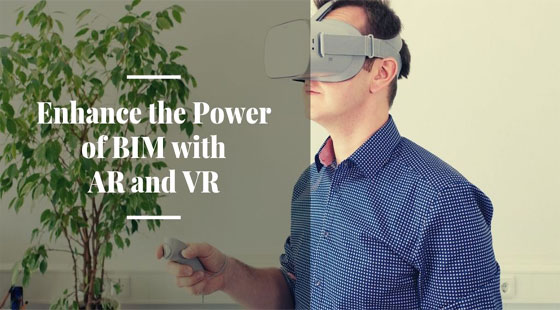Using AR and VR in BIM - Days are Changing
Tweet
As technologies evolve, so does our nature of imagining and visualizing something. Construction design is heavily dependent upon visualization, so it is no wonder that new data visualization technologies like AR and VR would influence and enhance BIM (Building Information Modelling) in leaps and bounds.
"The Fourth Wave", as it is termed in measuring technological growth of most industries, will be majorly a result of the Augmented Reality (AR) and Virtual Reality (VR). This growth wave shall determine how the AEC segment shall invest their time and money. We are indeed standing on the brink of a major breakthrough in terms of construction design process with AR and VR – and arguably, BIM would be the system benefitting most from this.
What is AR
The term 'AR' or Augmented Reality was first coined back in 1992, to express a system that can enhance and enrich the five senses. All our senses are tasked of injecting various kinds of information into our bodies; AR aims to add to that information, 'augmenting' it.
For example, when you are looking at a shoe someone is wearing, you are only looking at the shoe. If you aren't an expert on the present shoe market, you won't be able to what model or brand it is. However, what if you were wearing a pair of glasses with embedded displays in them, which would see what you are looking at, analyzing it? The display can then pop-up a little transparent box telling you exactly which brand and product those shoes were, and how much do they cost.
This same idea can be applied to objects in a construction site, or portions of a building getting constructed. How would you like to just look at a column and know its height, thickness, volume, and the loads on it? How about looking at a room and see it automatically color-shaded depending upon energy spent?
What is VR
Virtual Reality or VR existed in science fiction has been for a long time now, and it means creating a whole new world in a computer and presenting it to you using special devices in such a way that you feel you are living in that world.
For example, today we are recording 360-degree videos that capture everything around the camera, not just the front. Then we view them using special virtual reality goggles that block off the real world sight and instead show us the non-real 3D world. They can also sense when we move our head, tilting and turning the view accordingly. In effect, we feel that we are standing inside that 3D scene, in place of the cameraman.
In building information modeling, whole structures designed in CAD and rendered into photorealistic 3D scenes can be viewed by the engineers or architects, looking at the building inside and out, "getting the feel" of how the thing will become when constructed, long before even the first brick on site. This will help them inspect the flaws and needs in every nook and cranny of the structure, and relate and adjust the information accordingly.
How can BIM relate to VR and AR
BIM represents an object to be created in a digital universe. It holds the precise data about the object's physical and functional characteristics, and acts as a model of the following: Design, Program, Realization, Maintenance.
The above is true for any construction projects which utilizes a digital system of information modeling, containing information about various objects throughout their construction lifecycle.
Since all the information is digital, AR would be insanely helpful in BIM, with the support of right hardware.
Even at the very beginning, surveys would become ridiculously easy, when you just stand in middle of the site and look at different places, and the detailed survey data gets embedded in the project model.
In the modeling phase, an architect can just stand in space and add walls and columns by hand in a virtual 3D model. The BIM model gets calculated accordingly.
The engineers can then "walk through" this virtual model and make it fit the bill, fixing and adjusting the model as necessary. Estimators can input advices just looking at portions of the building and realizing its cost.
And at the construction phase, it gets so obvious how AR and VR can help BIM. How easy and fast the construction process be, if you can just look at a bean and know all about it? Add drones in the equation that can look at objects that are difficult for you to reach, and you can virtually fly around and through the building, an omniscient entity.
The spatial and geometric nature of the data used in BIM makes it especially responsive to the effects of VR and AR; and so, the construction design will leave the tables and go into 3D glasses. May require more walking around, though!

Gallery
Feel free to contact us for BIM requirements. One of our representative will respond you within 24 Hours. Send us your projects requirement today and grow your project.
Explore More !







